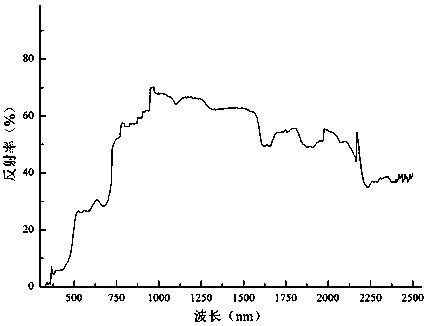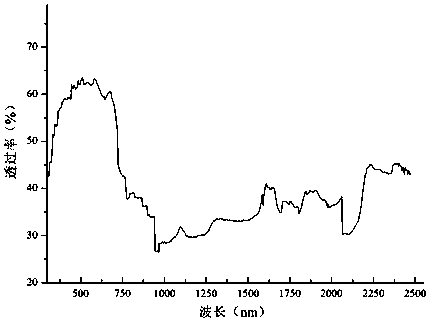Doped tin oxide material with near infrared reflection performance and preparation method of doped tin oxide material
A near-infrared and tin oxide technology, applied in the direction of tin oxide, etc., can solve the problems of material surface temperature rise, etc., and achieve the effect of little change in surface temperature, not easy to agglomerate, and small particle size
- Summary
- Abstract
- Description
- Claims
- Application Information
AI Technical Summary
Problems solved by technology
Method used
Image
Examples
Embodiment 1
[0026] (1) Dissolve tin chloride and titanium chloride in deionized water respectively, and the solvent mass is 20 times the total mass of tin salt and M salt;
[0027] (2) Carry out material mixing treatment and ultrasonically mix for 20 minutes to prepare a hydrothermal reaction precursor;
[0028] (3) Add urea to adjust the pH of the precursor solution to 8;
[0029] (4) Put the precursor solution in a closed hydrothermal reaction kettle, stir and react at 180°C for 6 hours, and the filling degree is 70%;
[0030] (5) The reaction precipitate was repeatedly washed with deionized water, dried at 100°C for 8 hours, pulverized at 5000 rpm for 10 minutes, and calcined at 500°C for 4 hours in a nitrogen atmosphere to obtain the target product.
Embodiment 2
[0032] (1) Dissolve tin chloride and ferric nitrate in ethanol, and the solvent mass is 100 times the total mass of tin salt and M salt;
[0033] (2) Perform material mixing treatment and ultrasonically mix for 25 minutes to obtain a hydrothermal reaction precursor;
[0034] (3) Add ammonia water to adjust the pH of the precursor solution to 9;
[0035] (4) Direct centrifugation to obtain the precipitate;
[0036] (5) The reaction precipitate was repeatedly washed with deionized water, dried at 90°C for 24 hours, pulverized at 6000 rpm for 5 minutes, and directly calcined in air at 500°C for 6 hours to obtain the target product.
Embodiment 3
[0038] (1) Dissolve tin chloride and copper sulfate in deionized water respectively, and the solvent mass is 20 times the total mass of tin salt and M salt;
[0039] (2) Perform material mixing treatment and ultrasonically mix for 30 minutes to obtain a hydrothermal reaction precursor;
[0040] (3) Add potassium hydroxide to adjust the pH of the precursor solution to 9;
[0041] (4) Put the precursor solution in a closed hydrothermal reactor, and stir and react at 160°C for 12 hours;
[0042] (5) The reaction precipitate was repeatedly washed with absolute ethanol, dried at 130°C for 10 hours, pulverized at 2000 rpm for 30 minutes, and calcined in air at 600°C for 3 hours to obtain the target product.
PUM
 Login to View More
Login to View More Abstract
Description
Claims
Application Information
 Login to View More
Login to View More - R&D Engineer
- R&D Manager
- IP Professional
- Industry Leading Data Capabilities
- Powerful AI technology
- Patent DNA Extraction
Browse by: Latest US Patents, China's latest patents, Technical Efficacy Thesaurus, Application Domain, Technology Topic, Popular Technical Reports.
© 2024 PatSnap. All rights reserved.Legal|Privacy policy|Modern Slavery Act Transparency Statement|Sitemap|About US| Contact US: help@patsnap.com









